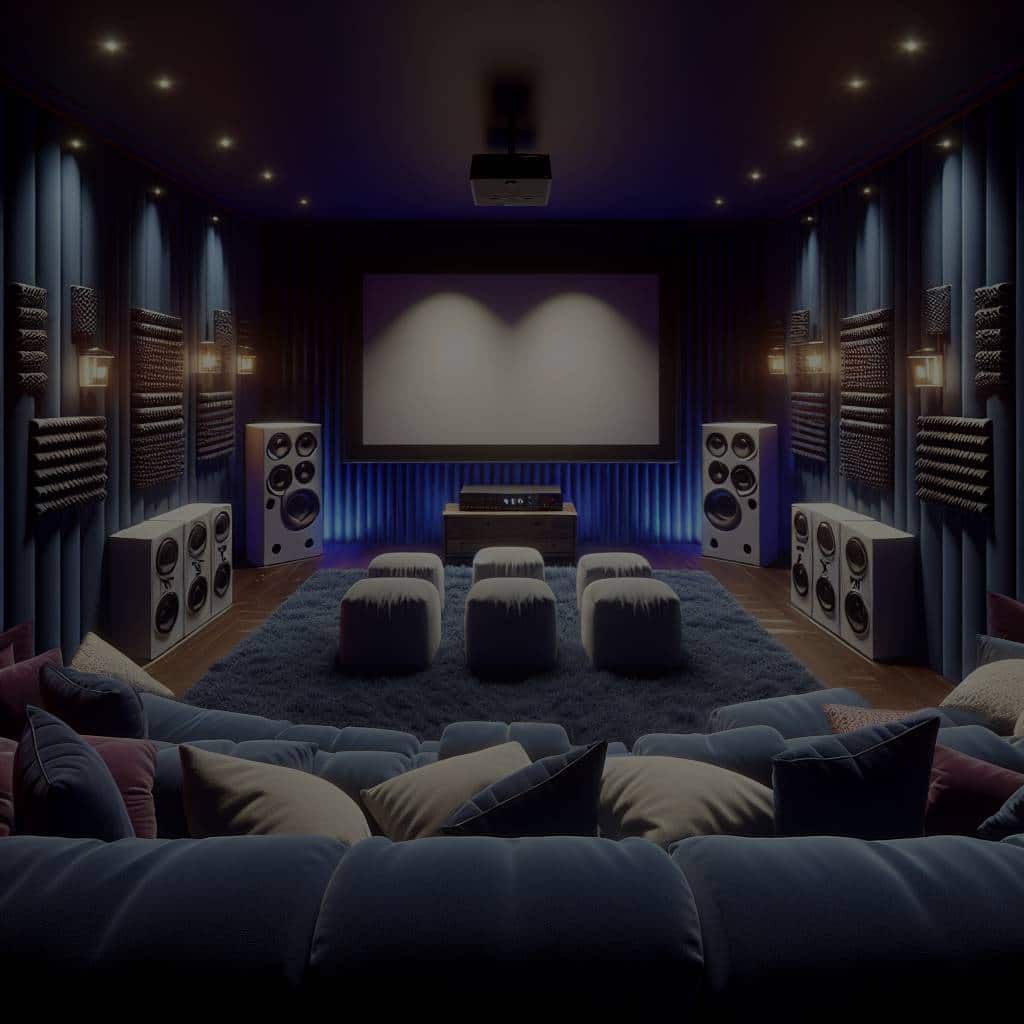Creating a home theater that provides an immersive audio experience is no small feat. If you have a room in your home that you’re ready to transform into a cinema-like space, then this is the guide for you. We will show you how to take your viewing and listening experience to the next level with optimal sound in a small home theater. Key considerations include acoustic panels, seating placement, sound design, and room acoustics. Let’s dive in.
Understanding the Acoustics of Your Room
Before leaping into the design process, it’s vital to understand the acoustics of your space. This involves examining the room’s layout and how sound waves will interact with the walls, ceiling, and objects inside it.
Also to see : What’s the Most Efficient Layout for a Home-Based Professional Podcast Studio?
The dimensions of your room play a significant role in your home theater’s acoustics. Rectangular rooms generally provide the best acoustics because they allow sound waves to disperse evenly. However, irregularly shaped rooms can still deliver an excellent audio experience with careful planning and adjustment.
The materials inside your room also affect its acoustics. Hard and flat surfaces, like bare walls and windows, tend to reflect sound waves, leading to echo and distortion. Conversely, soft and textured elements, such as rugs and curtains, absorb sound waves, helping to maintain a balanced audio environment.
Also to see : What’s the Best Way to Implement a Greywater System in a Suburban Home?
Incorporating Acoustic Panels
Acoustic panels contribute significantly to the audio experience in a home theater. They are designed to absorb, diffuse, or reflect sound waves, which enhances the clarity and depth of the sound produced by your audio system.
Acoustic panels come in various forms, including foam panels, diffusers, and bass traps. Foam panels absorb high-frequency sound waves to prevent echo. Diffusers scatter sound waves, reducing the impact of direct sound and creating a more balanced acoustic environment. Bass traps, on the other hand, absorb low-frequency sound waves to prevent the ‘boomy’ effect that bass can produce.
Placement of these panels is significant. For the best results, mount foam panels and diffusers on the walls and ceiling where direct sound waves from your speakers will hit. Bass traps should be placed in the corners of your room, where low-frequency sound waves are most likely to converge.
Carefully Choosing and Placing Your Speakers
The type of speakers and their placement in your theater room is a critical factor in your audio experience. Before purchasing speakers, consider the size of your room, the kind of audio you’ll be listening to, and how the speakers will interact with your room’s acoustics.
Floor-standing speakers, also known as tower speakers, are a popular choice. They are known for their rich and balanced sound, and they often include built-in subwoofers that enhance bass. However, they require more floor space than other speakers.
Bookshelf speakers are ideal for smaller rooms. They deliver a clear and detailed sound, but they may need to be paired with a separate subwoofer to achieve a deep bass effect.
For optimal audio, place your speakers in the shape of a triangle relative to your seating area, with one speaker on each side of the TV and the third behind your seating area.
Optimizing Seating for the Best Sound Experience
Your seating arrangement can greatly impact your home theater’s sound quality. For the optimal audio experience, consider the distance between your seating and speakers, the number of seats, and their arrangement.
First, ensure your seating is at the correct distance from your speakers. As a rule of thumb, your seating should be about twice the distance of the diagonal measurement of your TV screen from the speakers. For example, if you have a 50-inch TV, your seating should be about 100 inches away from the speakers.
The number of seats and their arrangement also impact your audio experience. A larger number of seats can absorb more sound, reducing echo. However, too many seats can obstruct sound waves, leading to an uneven sound distribution. Arrange your seats in a semicircular shape around your speakers for an immersive audio experience.
Adding a Personal Touch with Design
While technical aspects are essential in a home theater, personalizing the space creates a unique, cinema-like experience. Consider elements such as lighting, color schemes, and decor when designing your home theater.
Dimmable lighting gives you control over the brightness in the room, creating the perfect movie-watching ambiance. Choose a dark color scheme to absorb light and prevent reflections on your TV screen. Lastly, adding movie posters or memorabilia can give your home theater a unique and personal touch.
Designing a small home theater with optimal sound involves careful planning and consideration. By understanding your room’s acoustics, incorporating acoustic panels, choosing and placing your speakers correctly, optimizing your seating, and adding a personal touch with design, you can create a cinema-like space in your home that offers an unforgettable viewing and listening experience.
Identifying and Treating Reflection Points
In order to achieve ideal sound quality, it’s essential to pay close attention to reflection points in your home theater. These points are essentially spots where sound waves from your speakers bounce off the surfaces of the room, creating echoes and distorting the original sound.
Use a mirror to identify these reflection points. Start off by having someone move a mirror along the walls of the room. From your main seating position, you should be able to see the reflection of any speaker in the mirror. The points on the walls where you can see the speaker are your primary reflection points.
Once you’ve identified these points, it’s time to treat them. This is where acoustic treatment comes into play. Acoustic panels can be installed on these reflection points to absorb the sound waves and minimize reflection. Bass traps can be used in corners to absorb low-frequency sound waves and reduce the "boomy" effect.
However, it’s not just about placing panels and traps anywhere. You need to strategically place them at the reflection points for maximum effectiveness. This can turn a good home theater into an exceptional one. You can even use diffusers on the rear wall to scatter the reflected sound, creating a more immersive sound field.
Perfecting the Control Room and Seating Octane
The control room is the heart of your home theater. This is where the audio and video equipment is housed and controlled. The placement of your equipment can significantly affect the sound quality. As such, you should arrange your equipment in a way that minimizes interference with sound waves.
Having your equipment placed in a centralized location can help to ensure a consistent audio experience regardless of your seating position. Use a cabinet or shelf to house your equipment, ensuring it’s off the floor to reduce the risk of vibration. To avoid overheating, ensure that your equipment has plenty of ventilation.
As for the seating octane, this is where you’ll be spending most of your time, so it’s essential that it’s comfortable and positioned correctly. The ideal seating position is at a distance that’s about twice the width of your screen from the front wall. This puts you directly in line with the sound waves coming from your speakers, allowing for the best possible audio experience.
When arranging multiple rows of seats, use risers to elevate each row. This ensures that each viewer has an unobstructed view of the screen and is within the optimal audio range. Lastly, choose seats that are comfortable, durable and complement the decor of your home theater.
Conclusion
Designing a small home theater with optimal sound is not a simple task, but with careful planning and understanding of the principles of acoustics, you can create a space that rivals any commercial cinema. From treating reflection points with acoustic panels and bass traps, to perfecting your control room and seating octane, each step brings you closer to an immersive audiovisual experience. Remember to add your personal touch to make the space truly yours. Don’t rush the process, take your time to assess your space, tweak your layout, and test different arrangements. Remember, the ultimate goal is to create a home theater that offers impeccable sound quality, comfort, and a unique viewing experience right in the comfort of your own home.











